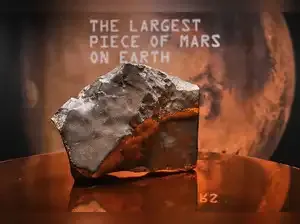A large Martian meteorite and a juvenile dinosaur skeleton are among rare natural history items heading to auction at Sotheby’s in New York during Geek Week 2025. The event includes 122 unique pieces.
Biggest Martian Rock on Earth Heads to Auction
Sotheby’s will auction the Martian meteorite known as NWA 16788 on Wednesday. It weighs 54 pounds (25 kilograms) and is the largest piece of Mars ever discovered on Earth. The estimated price is between $2 million and $4 million. The rock is 70% larger than any other Martian meteorite found before.
How was Martian rock Brought to Earth?
This Martian rock came to Earth after an asteroid struck Mars. The meteorite traveled 140 million miles (225 million kilometers) before landing in the Sahara Desert. A meteorite hunter found it in Niger in November 2023, according to Sotheby’s.
The rock’s size is significant. It represents almost 7% of all known Martian material on Earth. It measures about 15 by 11 by 6 inches (375 by 279 by 152 millimeters).
Also Read: Virgin River Season 7: Is release date confirmed? See what to expect, cast, new characters, key storylines and season 8 update
How Scientists Confirmed Martian Origin?
Experts removed a small piece of the meteorite and sent it to a lab for analysis. The lab confirmed the rock came from Mars. Scientists compared its chemical makeup to Martian meteorites identified during NASA’s Viking mission in 1976.
The analysis identified the rock as an olivine-microgabbroic shergottite. This type of rock forms when Martian magma cools slowly. It includes pyroxene and olivine minerals. The surface also shows signs of melting from Earth’s atmosphere, suggesting it burned during entry.
Dinosaur Skeleton from Jurassic Era Also on Sale
A juvenile Ceratosaurus skeleton will also be auctioned at Geek Week 2025. It stands over 6 feet (2 meters) tall and measures nearly 11 feet (3 meters) long. The estimate for this fossil is between $4 million and $6 million.
The dinosaur skeleton was found in 1996 near Laramie, Wyoming, at Bone Cabin Quarry. Experts used 140 fossil bones and sculpted materials to recreate the full skeleton. It is ready for display. Ceratosaurus dinosaurs were bipeds with short arms and are similar in appearance to the Tyrannosaurus rex, though smaller. This species lived around 150 million years ago.
Also Read: 3I/ATLAS: Alien spacecraft speeds toward Earth at 135,000 mph, claims scientist. See if its a threat
Part of Sotheby’s Geek Week 2025
The meteorite and dinosaur are featured in a 122-item auction. Sotheby’s Geek Week includes meteorites, fossils, and gem-quality minerals. The meteorite was previously displayed at the Italian Space Agency in Rome. The owner has not been named. Sotheby’s says the rock likely landed on Earth in recent years, based on testing.
The dinosaur skeleton was acquired by Fossilogic, a fossil mounting firm based in Utah. The auction offers collectors and researchers rare natural history items.
FAQs
What is the estimated price of the Martian meteorite at Sotheby’s auction?
The Martian meteorite, NWA 16788, is expected to sell for between $2 million and $4 million.
How was the Ceratosaurus skeleton prepared for auction?
Experts used 140 fossil bones and sculpted parts to mount and prepare the juvenile Ceratosaurus skeleton for display.
Biggest Martian Rock on Earth Heads to Auction
Sotheby’s will auction the Martian meteorite known as NWA 16788 on Wednesday. It weighs 54 pounds (25 kilograms) and is the largest piece of Mars ever discovered on Earth. The estimated price is between $2 million and $4 million. The rock is 70% larger than any other Martian meteorite found before.How was Martian rock Brought to Earth?
This Martian rock came to Earth after an asteroid struck Mars. The meteorite traveled 140 million miles (225 million kilometers) before landing in the Sahara Desert. A meteorite hunter found it in Niger in November 2023, according to Sotheby’s.The rock’s size is significant. It represents almost 7% of all known Martian material on Earth. It measures about 15 by 11 by 6 inches (375 by 279 by 152 millimeters).
Also Read: Virgin River Season 7: Is release date confirmed? See what to expect, cast, new characters, key storylines and season 8 update
How Scientists Confirmed Martian Origin?
Experts removed a small piece of the meteorite and sent it to a lab for analysis. The lab confirmed the rock came from Mars. Scientists compared its chemical makeup to Martian meteorites identified during NASA’s Viking mission in 1976.The analysis identified the rock as an olivine-microgabbroic shergottite. This type of rock forms when Martian magma cools slowly. It includes pyroxene and olivine minerals. The surface also shows signs of melting from Earth’s atmosphere, suggesting it burned during entry.
Dinosaur Skeleton from Jurassic Era Also on Sale
A juvenile Ceratosaurus skeleton will also be auctioned at Geek Week 2025. It stands over 6 feet (2 meters) tall and measures nearly 11 feet (3 meters) long. The estimate for this fossil is between $4 million and $6 million.The dinosaur skeleton was found in 1996 near Laramie, Wyoming, at Bone Cabin Quarry. Experts used 140 fossil bones and sculpted materials to recreate the full skeleton. It is ready for display. Ceratosaurus dinosaurs were bipeds with short arms and are similar in appearance to the Tyrannosaurus rex, though smaller. This species lived around 150 million years ago.
Also Read: 3I/ATLAS: Alien spacecraft speeds toward Earth at 135,000 mph, claims scientist. See if its a threat
Part of Sotheby’s Geek Week 2025
The meteorite and dinosaur are featured in a 122-item auction. Sotheby’s Geek Week includes meteorites, fossils, and gem-quality minerals. The meteorite was previously displayed at the Italian Space Agency in Rome. The owner has not been named. Sotheby’s says the rock likely landed on Earth in recent years, based on testing.The dinosaur skeleton was acquired by Fossilogic, a fossil mounting firm based in Utah. The auction offers collectors and researchers rare natural history items.
FAQs
What is the estimated price of the Martian meteorite at Sotheby’s auction?
The Martian meteorite, NWA 16788, is expected to sell for between $2 million and $4 million.
How was the Ceratosaurus skeleton prepared for auction?
Experts used 140 fossil bones and sculpted parts to mount and prepare the juvenile Ceratosaurus skeleton for display.








